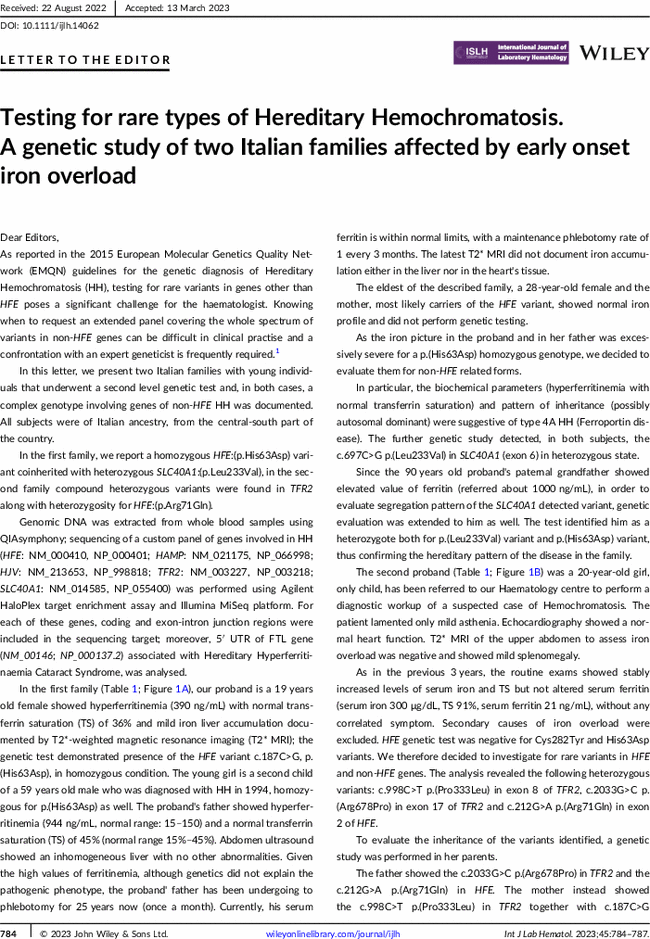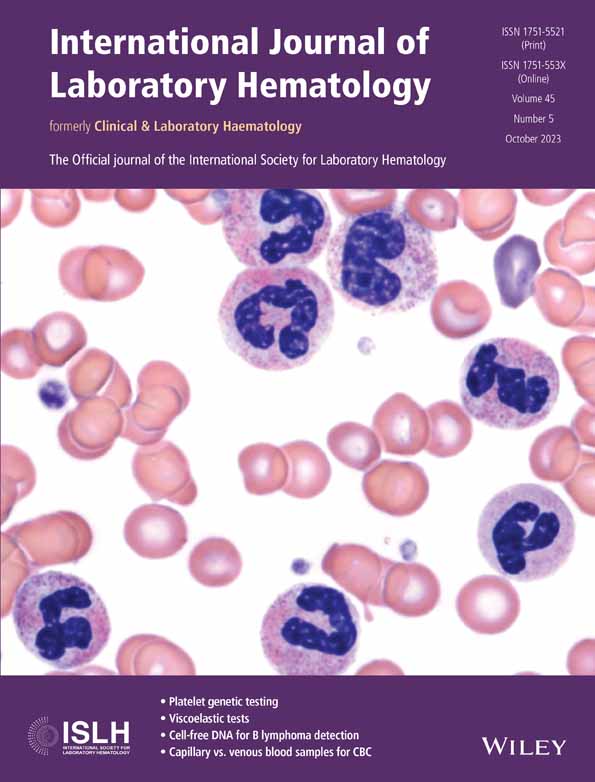Testing for rare types of Hereditary Hemochromatosis. A genetic study of two Italian families affected by early onset iron overload
Corresponding Author
Alessandro Atanasio
CRIMM, Centre of Research and Innovation in Myeloproliferative Neoplasms, University of Florence, Florence, Italy
Department of Experimental and Clinical Medicine, University of Florence, Florence, Italy
Correspondence
Alessandro Atanasio, CRIMM, Centre of Research and Innovation in Myeloproliferative Neoplasms, University of Florence, Florence, Italy and Department of Experimental and Clinical Medicine, University of Florence, Florence, Italy.
Email: [email protected]
Search for more papers by this authorSara Bernabini
Department of Experimental and Clinical Medicine, University of Florence, Florence, Italy
Genetic Diagnostic Unit, Careggi University Hospital, Florence, Italy
Search for more papers by this authorAngela Consagra
Department of Experimental and Clinical Medicine, University of Florence, Florence, Italy
Search for more papers by this authorIrene Giotti
Department of Experimental and Clinical Medicine, University of Florence, Florence, Italy
Genetic Diagnostic Unit, Careggi University Hospital, Florence, Italy
Search for more papers by this authorValentina Carrai
Department of Experimental and Clinical Medicine, University of Florence, Florence, Italy
Search for more papers by this authorElisabetta Pelo
Department of Experimental and Clinical Medicine, University of Florence, Florence, Italy
Genetic Diagnostic Unit, Careggi University Hospital, Florence, Italy
Search for more papers by this authorAlessandro Maria Vannucchi
CRIMM, Centre of Research and Innovation in Myeloproliferative Neoplasms, University of Florence, Florence, Italy
Department of Experimental and Clinical Medicine, University of Florence, Florence, Italy
Search for more papers by this authorCorresponding Author
Alessandro Atanasio
CRIMM, Centre of Research and Innovation in Myeloproliferative Neoplasms, University of Florence, Florence, Italy
Department of Experimental and Clinical Medicine, University of Florence, Florence, Italy
Correspondence
Alessandro Atanasio, CRIMM, Centre of Research and Innovation in Myeloproliferative Neoplasms, University of Florence, Florence, Italy and Department of Experimental and Clinical Medicine, University of Florence, Florence, Italy.
Email: [email protected]
Search for more papers by this authorSara Bernabini
Department of Experimental and Clinical Medicine, University of Florence, Florence, Italy
Genetic Diagnostic Unit, Careggi University Hospital, Florence, Italy
Search for more papers by this authorAngela Consagra
Department of Experimental and Clinical Medicine, University of Florence, Florence, Italy
Search for more papers by this authorIrene Giotti
Department of Experimental and Clinical Medicine, University of Florence, Florence, Italy
Genetic Diagnostic Unit, Careggi University Hospital, Florence, Italy
Search for more papers by this authorValentina Carrai
Department of Experimental and Clinical Medicine, University of Florence, Florence, Italy
Search for more papers by this authorElisabetta Pelo
Department of Experimental and Clinical Medicine, University of Florence, Florence, Italy
Genetic Diagnostic Unit, Careggi University Hospital, Florence, Italy
Search for more papers by this authorAlessandro Maria Vannucchi
CRIMM, Centre of Research and Innovation in Myeloproliferative Neoplasms, University of Florence, Florence, Italy
Department of Experimental and Clinical Medicine, University of Florence, Florence, Italy
Search for more papers by this author
Open Research
DATA AVAILABILITY STATEMENT
Data supporting the findings of this study are available upon request from the corresponding author. The data are not publicly available due to privacy or ethical restrictions.
REFERENCES
- 1Porto G, Brissot P, Swinkels DW, et al. EMQN best practice guidelines for the molecular genetic diagnosis of hereditary hemochromatosis (HH). Eur J Hum Genet. 2016; 24(4): 479-495. doi:10.1038/ejhg.2015.128
- 2Richards S, Aziz N, Bale S, et al. Standards and guidelines for the interpretation of sequence variants: a joint consensus recommendation of the American College of Medical Genetics and Genomics and the Association for Molecular Pathology. Genet Med. 2015; 17(5): 405-424. doi:10.1038/gim.2015.30
- 3Ravasi G, Pelucchi S, Russo A, Mariani R, Piperno A. Ferroportin disease: a novel SLC40A1 mutation. Dig Liver Dis. 2020; 52(6): 688-690. doi:10.1016/j.dld.2020.03.013
- 4Girelli D, De Domenico I, Bozzini C, et al. Clinical, pathological, and molecular correlates in ferroportin disease: a study of two novel mutations. J Hepatol. 2008; 49(4): 664-671. doi:10.1016/j.jhep.2008.05.028
- 5Bardou-Jacquet E, Cunat S, Beaumont-Epinette MP, et al. Variable age of onset and clinical severity in transferrin receptor 2 related haemochromatosis: novel observations. Br J Haematol. 2013; 162(2): 278-281. doi:10.1111/bjh.12350
- 6Dubljevic V, Sali A, Goding JW. A conserved RGD (Arg-Gly-Asp) motif in the transferrin receptor is required for binding to transferrin. Biochem J. 1999; 341(Pt 1): 11-14.
- 7Ravasi G, Rausa M, Pelucchi S, et al. Transferrin receptor 2 mutations in patients with juvenile hemochromatosis phenotype. Am J Hematol. 2015; 90(12): E226-E227. doi:10.1002/ajh.24202




